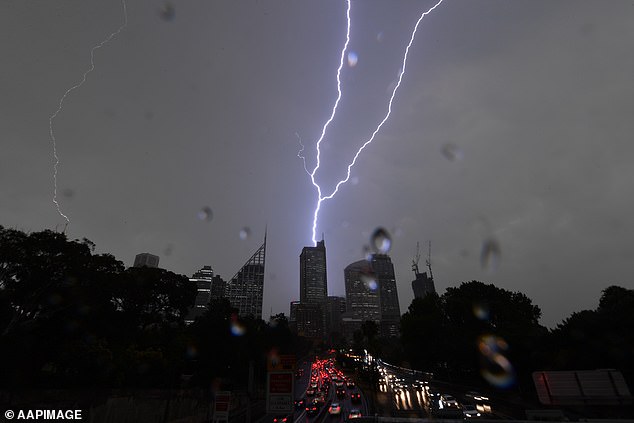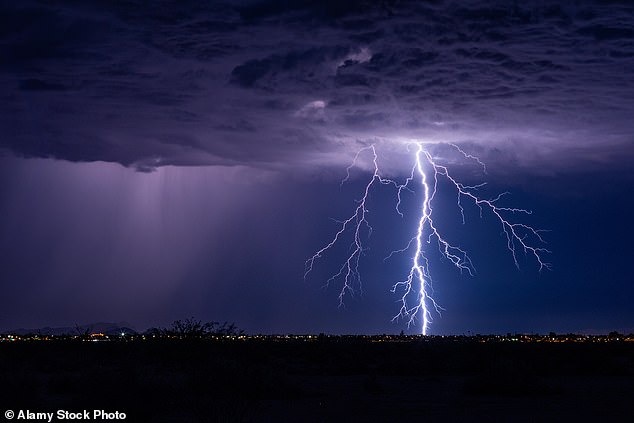A leading government health body has issued official guidance about an increasingly common reaction to thunderstorms—life-threatening asthma attacks.
And, terrifyingly, the dust and debris whipped up by the atmospheric events also have the potential to trigger an attack in people who do not have asthma.
In the newly released guidance about thunderstorm asthma, the UK Health Security Agency (UKHSA) noted a case of the weather-related medical phenomena which occurred in Melbourne, Australia in 2016 which left ten people dead.
This, the governing body explains, happened because ‘thunderstorm activity is linked to an increase in people reporting asthma symptoms and seeking medical attention for breathing issues.
‘It has been observed since the 1980s, with notable events in Birmingham in 1983, and a severe event in Melbourne in 2016, which overwhelmed the city’s ambulance system and resulted in 10 deaths.’
So what causes thunderstorm asthma? In the run up to a thunderstorm, particularly in the spring and summer months, high winds can whip up pollen spores.
As they swirl in the air, they are caught up in lightning strikes, which make the particles even smaller—and more easily breathed in.
This, explained a leading doctor, can trigger huge asthma attacks—even in people who are not formally diagnosed with the condition.

More than 7 million people in the UK have an asthma diagnosis
Jonathan Grigg, Professor of Paediatric Respiratory and Environmental Medicine at Queen Mary University London, said: ‘It’s not something that only affects individuals who’ve had a history of wheezing.
‘If you start wheezing during a thunderstorm, where there’s high pollen, then it could well be thunderstorm asthma.
‘People who’ve got asthma know to take the appropriate precautions, but thunderstorm asthma is something that everyone should know about.
‘The idea behind it is that in thunderstorms, you’ve got rain and lightning, and in the presence of high pollen counts, this transforms and breaks up the pollen, and those little bits get right deep into the lung.
‘If you’re sensitive to that, it will trigger severe asthma, or make asthma worse—but it can also trigger asthma, even if you’ve never had it.’
Professor Grigg recalled a notable case of youngsters who had had asthma attacks during a thunderstorm which happened just two years ago.
He said: ‘In London in 2023, there was a similar event with thunderstorms and pollen, and we saw quite a few children with asthma coming in.
‘I think about half had no history of actual asthma.’

Thunderstorm asthma can also occur in urban locations, and is connected to air pollution
This echoes the UKHSA’s guidance, which states: ‘Everyone can be at risk of thunderstorm asthma, but young adults under 30 are more likely to be affected.
‘There is also some limited evidence that people who have asthma (both diagnosed and undiagnosed), and those who have hay fever, are also more at-risk from the impacts of thunderstorm asthma.’
Professor Grigg continued that people travelling abroad also need to know the warning signs, and take necessary precautions.
Climate change is making weather patterns across the globe more unpredictable and dramatic—and with an increase in air pollution, which has also been linked to respiratory conditions—thunderstorm asthma is becoming a growing risk.
‘As you move further south across the European continent, you’ve got areas around mountains which have high pollen, and thunderstorms which happen all the time, so we, fortunately don’t, in the UK, get as many cases of thunderstorm asthma as other areas.’
He also shared some As well as ‘knowing the pollen count’, Professor Grigg explained that there are steps you can take to reduce the risk of suffering a thunderstorm asthma attack.
‘If the pollen count is very high and there’s a thunderstorm, especially ones with gusty winds, then you shouldn’t be outside.
‘Stay indoors and shut the windows.

Thunderstorms look impressive… but they can kill
‘You definitely shouldn’t be wandering around, especially in the beginning of a storm when you get very windy conditions.
‘Make sure that you’re taking your inhaler, especially the the steroid preventer inhaler, and carry your reliever with you.
‘Ensure you’re fully medicated as you’re as instructed by your physician.’
The same advice applies for if you’re caught up in a thunderstorm in an urban area, too.
‘If you have high pollen, high pollution and thunderstorm, you could get a perfect conditions for thunderstorm asthma,’ he warned.
Asthma affects around 7.2million people in the UK, and asthma attacks kill, on average, three people in Britain every day.
It affects the airways, or breathing tubes, that carry air in and out of the lungs, causing them to become inflamed.
This makes the airways narrower so less air gets into and out of the lungs.
Symptoms include wheezing, breathlessness, a cough or a tight chest — and are often triggered by factors in the environment like pollution, stress or a cold.
There is no cure, but inhalers work to control the disease by reducing the number of blood cells that contribute to the lung inflammation.
Emma Rubach, Head of Health Advice at Asthma + Lung UK, said: ‘People with asthma who have hay fever can experience much more severe symptoms during thunderstorms.
‘This is because thunder breaks pollen into smaller particles, which can then be inhaled deep into the lungs, causing wheezing, coughing, a tight chest and shortness of breath.
‘If there is also higher pollution in the atmosphere – which tends to be the case when the weather is warm – this is an added threat.’












